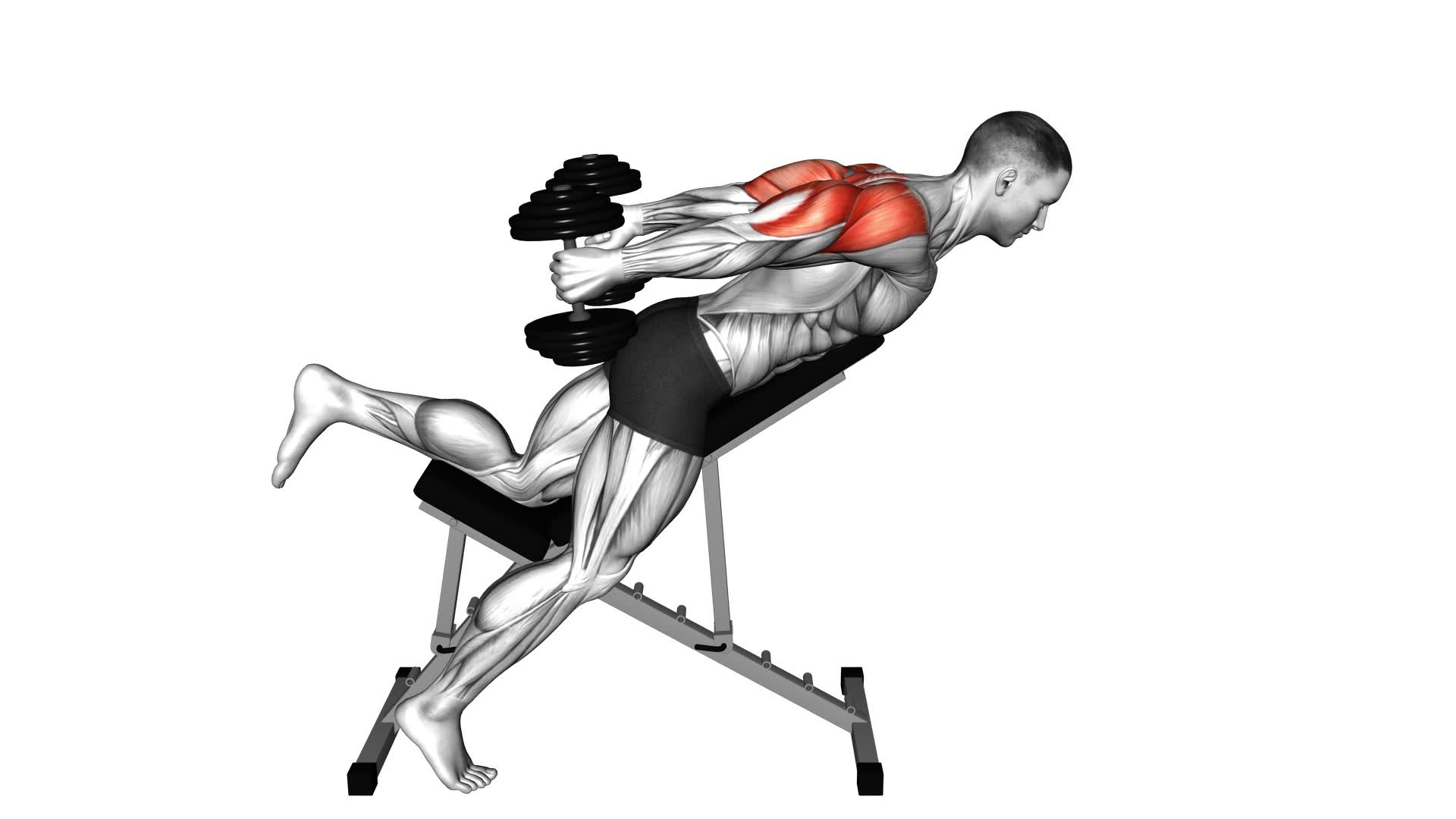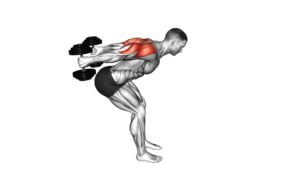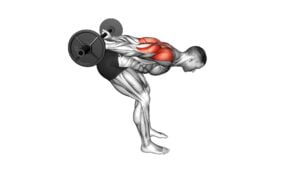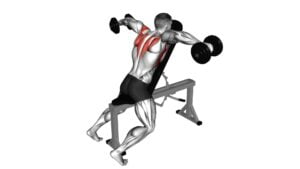Dumbbell Incline Reverse Raise With Chest Supported (Skier) (Male) – Video Exercise Guide & Tips

Are you looking to target your chest muscles and improve your upper body strength? Try the Dumbbell Incline Reverse Raise With Chest Supported (Skier) exercise!
Watch This Exercise Video
In this video exercise guide, we'll show you the proper equipment and set-up, along with step-by-step instructions on how to perform the exercise correctly.
Avoid common mistakes and maximize the effectiveness of this workout with our helpful tips.
Get ready to take your fitness routine to the next level!
Key Takeaways
- The Dumbbell Incline Reverse Raise with Chest Supported (Skier) exercise targets the deltoids and trapezius muscles, increasing shoulder and upper back strength.
- Proper form and technique, such as avoiding swinging or jerking the arms, raising weights too high, and arching the back, should be maintained during the exercise.
- Engaging the core muscles for stability, focusing on controlled movements, and lifting dumbbells to shoulder height are key tips for maximizing the effectiveness of this exercise.
- Gradually increasing the weight and varying the tempo can enhance the effectiveness of the exercise, while alternative variations, such as using resistance bands, can add variety to the workout routine.
Benefits of the Dumbbell Incline Reverse Raise With Chest Supported (Skier) Exercise
You will experience increased shoulder and upper back strength when you perform the dumbbell incline reverse raise with chest supported (skier) exercise. This exercise specifically targets your deltoids and trapezius muscles, helping you build a strong and defined upper body. The incline position adds an extra challenge, increasing the effectiveness of the exercise.
One of the main benefits of this exercise is improved shoulder stability. As you raise the dumbbells in a reverse motion, your shoulders are required to work harder to maintain control and stability throughout the movement. This can help prevent injuries and improve your overall shoulder strength.
Another benefit is the activation of your upper back muscles. The reverse motion targets the rear deltoids and upper back muscles, helping to improve posture and reduce the risk of rounded shoulders. This exercise can also enhance your overall upper body strength and muscular endurance.
To add variety to your workout routine, you can try different variations of the dumbbell incline reverse raise. You can adjust the incline bench to different angles to target specific areas of your shoulders and upper back. Additionally, you can perform the exercise with different grip positions, such as palms facing down or palms facing up, to engage different muscles.
Now that you understand the benefits of the dumbbell incline reverse raise with chest supported (skier) exercise, let's move on to the proper equipment and set-up for this exercise.
Proper Equipment and Set-up for the Exercise
To properly perform the dumbbell incline reverse raise with chest supported (skier) exercise, ensure that you have the necessary equipment and set-up.
First, you'll need an incline bench that can be adjusted to a 45-degree angle. This will provide the proper support for your chest during the exercise. Additionally, you'll need a pair of dumbbells that are of appropriate weight for your fitness level. It's important to choose a weight that challenges you, but still allows you to maintain proper form throughout the exercise.
Once you have the equipment ready, set up the incline bench at a 45-degree angle and place it in a sturdy and stable position. Make sure the dumbbells are within reach and easily accessible. Lie face down on the incline bench with your chest supported and your feet planted firmly on the ground.
Now that you have the equipment and set-up ready, you can begin the exercise. It's important to note that there are variations of this exercise that can be done with different equipment, such as resistance bands or cable machines. These variations can provide additional challenges or target specific muscles in different ways. However, for the dumbbell incline reverse raise with chest supported exercise, the equipment and set-up described above are essential for proper execution.
Step-by-Step Guide: How to Perform the Dumbbell Incline Reverse Raise With Chest Supported (Skier)
To perform the dumbbell incline reverse raise with chest supported (skier), start by lying face down on the incline bench with your chest supported and your feet firmly planted on the ground. Hold a dumbbell in each hand, palms facing down, and let your arms hang straight down towards the floor. This is your starting position.
Next, engage your core and glutes to maintain stability throughout the exercise. Keeping your arms straight, slowly lift them out to the sides and up towards your shoulders, squeezing your shoulder blades together at the top of the movement. Make sure to keep your elbows slightly bent and avoid any swinging or jerking motions.
Lower the dumbbells back to the starting position in a controlled manner, maintaining tension in your muscles throughout the entire range of motion.
For modification options, you can start with lighter dumbbells or perform the exercise without any weights until you build enough strength. Alternatively, you can decrease the incline of the bench to make the exercise easier or increase the incline to make it more challenging.
To add variations and progressions, you can try using resistance bands instead of dumbbells, or increase the weight of the dumbbells as you get stronger. Additionally, you can perform the exercise on a stability ball instead of an incline bench to engage your core muscles even more.
Remember to always listen to your body and choose the options that work best for you.
Common Mistakes to Avoid During the Exercise
Avoid swinging or jerking your arms during the dumbbell incline reverse raise with chest supported (skier) exercise. Maintaining proper form is crucial to maximize the effectiveness of this exercise and prevent injury. Here are three common mistakes to avoid:
- Using momentum: Swinging or jerking your arms can take away the focus from the targeted muscles and reduce the effectiveness of the exercise. Instead, concentrate on controlled movements, lifting the dumbbells in a smooth and controlled manner.
- Raising the weights too high: While it's important to lift the dumbbells to shoulder height, avoid lifting them too high, as it can put unnecessary strain on your shoulders and compromise your form. Focus on bringing the dumbbells up to a comfortable and controlled position.
- Arching your back: Maintaining a neutral spine is crucial during this exercise. Arching your back can lead to back pain and reduce the effectiveness of the exercise. Keep your core engaged and ensure that your back remains flat against the bench throughout the movement.
By avoiding these common mistakes and maintaining proper form, you can reap the full benefits of the dumbbell incline reverse raise with chest supported (skier) exercise.
Now, let's move on to some tips to maximize its effectiveness.
Tips for Maximizing the Effectiveness of the Dumbbell Incline Reverse Raise With Chest Supported (Skier)
Engage your core muscles and maintain a stable position throughout the movement to maximize the effectiveness of the dumbbell incline reverse raise with chest supported (skier) exercise. By focusing on your core, you'll enhance your stability and control, allowing for a more intense and targeted workout.
To further maximize the intensity of this exercise, it's essential to choose the appropriate weight for your dumbbells. Start with a weight that challenges you but still allows for proper form and control. As you progress, gradually increase the weight to continue challenging your muscles and promoting growth.
In addition to using the correct weight, varying the tempo of the exercise can also enhance its effectiveness. Try performing the dumbbell incline reverse raise with chest supported (skier) exercise at a slower pace, focusing on the eccentric (lowering) phase of the movement. This will increase time under tension, promoting muscle growth and strength gains.
For those looking for alternative variations of the exercise, you can try using resistance bands instead of dumbbells. The resistance bands provide a different type of resistance and engage your muscles in a slightly different way.
Remember to always listen to your body and adjust the intensity of the exercise accordingly. If you experience any discomfort or pain, it's important to stop and consult with a healthcare professional.
Frequently Asked Questions
How Many Reps and Sets Should I Do for the Dumbbell Incline Reverse Raise With Chest Supported (Skier) Exercise?
To effectively target the rear delts with the dumbbell incline reverse raise with chest supported (skier) exercise, it's recommended to perform 3 sets of 10-12 reps.
This exercise can help strengthen and tone the muscles in your shoulders and upper back.
To ensure proper form and technique, start with a light weight and focus on squeezing your shoulder blades together as you lift the dumbbells.
Remember to keep your chest supported on the incline bench throughout the movement.
Can I Modify the Exercise if I Don't Have Access to an Incline Bench?
If you don't have access to an incline bench, you can modify the dumbbell incline reverse raise exercise by using a stability ball or a flat bench instead. Simply lie face down on the stability ball or flat bench and perform the exercise as you'd on an incline bench.
This modification still targets your upper back and shoulders effectively. Additionally, the dumbbell incline reverse raise has benefits for women as it helps improve posture and strengthen the upper body muscles.
Is It Necessary to Use Dumbbells for This Exercise, or Can I Use Other Types of Weights?
You can definitely use alternative weights for this exercise if you don't have access to dumbbells. Other options like resistance bands or kettlebells can work well too. The key is to choose a weight that challenges you but allows you to maintain proper form throughout the exercise.
As for beginners, this exercise can be beneficial as it targets the posterior deltoids and upper back muscles, helping to improve posture and upper body strength.
Can Women Also Benefit From Doing the Dumbbell Incline Reverse Raise With Chest Supported (Skier) Exercise?
Yes, women can also benefit from doing the dumbbell incline reverse raise with chest supported exercise. This exercise targets the posterior deltoids, which can help improve shoulder strength and stability. It also engages the upper back muscles, promoting better posture.
To properly perform this exercise, lie face down on an incline bench with dumbbells in your hands. Raise your arms out to the sides, keeping your elbows slightly bent. Lower the dumbbells back down and repeat for a set number of reps.
Are There Any Variations or Progressions That I Can Incorporate Into This Exercise to Make It More Challenging?
To make the dumbbell incline reverse raise with chest supported (skier) exercise more challenging, there are several variations and progressions you can try.
One option is to increase the weight of the dumbbells you're using.
Another option is to add more repetitions or sets to your workout.
You could also try incorporating a pause at the top of the movement or slowing down the tempo.
These variations will help to challenge your muscles and continue to progress in your fitness journey.
Conclusion
In conclusion, the Dumbbell Incline Reverse Raise With Chest Supported (Skier) exercise is a beneficial exercise that targets the upper back and shoulders.
By using proper equipment and following the step-by-step guide, you can perform this exercise effectively.
Avoid common mistakes and maximize its effectiveness by implementing the tips provided.
Incorporate this exercise into your workout routine to strengthen and tone your upper body muscles.

Author
Years ago, the spark of my life’s passion ignited in my mind the moment I stepped into the local gym for the first time. The inaugural bead of perspiration, the initial endeavor, the very first surge of endorphins, and a sense of pride that washed over me post-workout marked the beginning of my deep-seated interest in strength sports, fitness, and sports nutrition. This very curiosity blossomed rapidly into a profound fascination, propelling me to earn a Master’s degree in Physical Education from the Academy of Physical Education in Krakow, followed by a Sports Manager diploma from the Jagiellonian University. My journey of growth led me to gain more specialized qualifications, such as being a certified personal trainer with a focus on sports dietetics, a lifeguard, and an instructor for wellness and corrective gymnastics. Theoretical knowledge paired seamlessly with practical experience, reinforcing my belief that the transformation of individuals under my guidance was also a reflection of my personal growth. This belief holds true even today. Each day, I strive to push the boundaries and explore new realms. These realms gently elevate me to greater heights. The unique combination of passion for my field and the continuous quest for growth fuels my drive to break new ground.







